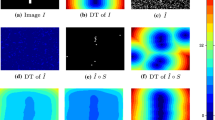Abstract
This design of optimal filters depends upon the random processes under consideration and the operator class from which a filter is to be chosen. Analytic derivation of an optimal filter is facilitated by finding partial descriptors of the random processes that facilitate analytic derivation of an optimal filter from the descriptors—for linear filtering, derivation of the optimal filter is via the covariance function. For nonlinear filtering of random sets (binary images), an analogous approach applies to the derivation of an optimal granulometric bandpass filter (GBF) by means of the granulometric size densities (GSDs) of the signal and noise. A GBF operates by passing or not passing components of a random set. For simply shaped grains having convenient analytic description, finding the GSD is not too difficult; however, when the disjoint union results from the segmentation of a non-disjoint union, the resulting process, and its GSD, can become very complex. This paper postulates a constrained overlap random-set model, and then finds the GSD for the segmented random set. The primary grain of the random model is a disk of random radius and segmentation is via the watershed transformation. Even for a union of disks, modest intersection greatly enhances the difficulty of finding the GSD, and therefore of designing optimal bandpass filters. Although application to disks is specialized, it gives quantitative insight into the effects of grain overlapping and segmentation. Such restriction to a tractable model is not uncommon in the literature of random sets when quantitative estimation results are desired.
Similar content being viewed by others
References
F. Baccelli and B. Blaszczyszyn, “On a coverage process ranging from the Boolean model to the PoissonVoronoi tessellation, with applications to wireless communications,” Advances in Applied Probability, Vol. 33, 2001.
Y. Chen and E.R. Dougherty, “Optimal and adaptive reconstructive granulometric bandpass filters,” Signal Processing, Vol. 61, pp. 65–81, 1997.
P.J. Diggle, Statistical Analysis of Point Processes, Chapman and Hall: London, 1983.
E.R. Dougherty, “Optimal binary morphological bandpass filters induced by granulometric spectral representation,” Mathematical Imaging and Vision, Vol. 7, No. 2, 1997.
E.R. Dougherty, Random Processes for Image and Signal Processing, SPIE and IEEE Press: Bellingham, 1998.
E.R. Dougherty and Y. Chen, “Granulometric filters,” in Nonlinear Filters for Image Processing, E.R. Dougherty and J.T. Astola (Eds.), SPIE and IEEE Press: Bellingham, 1999, pp. 121–162.
E.R. Dougherty and Y. Chen, “Robust optimal granulometric bandpass filters,” Signal Processing, Vol. 81, No. 7, pp. 1357–1372, 2001.
E.R. Dougherty and Y. Chen, “Optimal and adaptive design of logical granulometric filters,” in Advances in Imaging and Electron Physics, P.W Hawkes (Ed.),Vol. 117, Academic Press: New York, 2001, pp. 1–71.
E.R. Dougherty and C. Cuciurean-Zapan, “Optimal reconstructive τ-openings for disjoint and statistically modeled nondisjoint grains,” Signal Processing, Vol. 56, pp. 45–58, 1997.
A.M. Grygorian and E.R. Dougherty, “Bayesian robust optimal linear filters,” Signal Processing, Vol. 81, No. 2, pp. 2503–2521, 2001.
O. Haggerstrom and R. Meester, “Nearest neighbor and hard sphere models in continuum percolation, Random Structures and Algorithms, Vol. 9, pp. 295–315, 1996.
P. Hall, Introduction to Coverage Processes, John Wiley: New York, 1988.
G. Matheron, Random Sets and Integral Geometry, JohnWiley: New York, 1975.
F. Meyer and S. Beucher, “Morphological segmentation,” Visual Communication and Image Representation, Vol. 1, No. 1, 1990.
I. Molchanov, Statistics of the Boolean Model for Practitioners and Mathematicians, John Wiley: New York, 1997.
F. Sand and E.R. Dougherty, “Robustness of granulometric moments,” Pattern Recognition, Vol. 32, pp. 1657–1665, 1999.
K. Sivakumar and J. Goutsias, “Discrete morphological size distributions and densities: Estimation techniques and applications,” Electronic Imaging, Vol. 6, No. 1, pp. 31–53, 1997.
D. Stoyan, “Random sets: Models and statistics,” International Statistical Review, Vol. 66, pp. 1–27, 1998.
S. Verdu and H.V. Poor, “On minimax robustness: A general approach and applications,” IEEE Trans. on Information Theory, Vol. 30, No. 2, pp. 328–340, 1984.
Author information
Authors and Affiliations
Rights and permissions
About this article
Cite this article
Dougherty, E.R. Granulometric Size Density for Segmented Random-Disk Models. Journal of Mathematical Imaging and Vision 17, 271–281 (2002). https://doi.org/10.1023/A:1020767610609
Issue Date:
DOI: https://doi.org/10.1023/A:1020767610609




